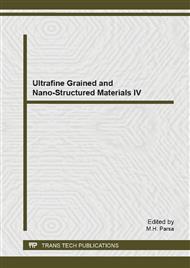[1]
A. Garcia, M. Llusar, S. Sorli, J. Calbo, M. A. Tena, G. Monros, Effect of the surfactant and precipitant on the synthesis of pink coral by a microemulsion method, J. Eur. Ceram. Soc. 23 (2003) 1829-1838.
DOI: 10.1016/s0955-2219(02)00451-x
Google Scholar
[2]
B. Federica, M. Tiziano, S. Cristina, F. A. Maria, New glass ceramic inclusion pigment, J. Am. Ceram. Soc. 88 (2005) 1070-1071.
Google Scholar
[3]
M. Hosseini-Zori, F. Bondioli, T. Manfredini, E. Taheri-Nassaj, Effect of synthesis parameters on a hematite silica red pigment obtained using a co-precipitation route, Dyes and Pigments. 77 (2008) 53-58.
DOI: 10.1016/j.dyepig.2007.03.006
Google Scholar
[4]
Y. Zhang, R. Pinggen, L. Ming, Z. Dezhao, W. Jianqing, Synthesis and color evolution of silica-coated hematite nanoparticles, J. Am. Ceram. Soc. 92.
Google Scholar
[8]
(2009) 1877-1880.
Google Scholar
[5]
M. Llusar, V. Royo, J.A. Badenes, M. A. Tena, Nanocomposite Fe2O3–SiO2 inclusion pigments from post functionalized mesoporous silicas, J. Eur. Ceram. Soc. 29 (2009) 3319-3332.
DOI: 10.1016/j.jeurceramsoc.2009.07.018
Google Scholar
[6]
M. Hosseini-Zori, E. Taheri-Nassaj, Nano encapsulation of hematite into silica matrix as a red inclusion ceramic pigment, J. Alloys Compd. 510 (2012) 83- 86.
DOI: 10.1016/j.jallcom.2011.08.086
Google Scholar
[7]
A. Moosavi, A. Aghaei, Comparison of solution combustion and co-precipitation methods in synthesis of iron zircon coral pigment, Pigm Resin Technol. 39 (2010) 203-207.
DOI: 10.1108/03699421011055509
Google Scholar
[8]
C. Hongtao, R. Wanzhong, A new chemical strategy: mineralizer-free synthesis of iron zircon ultrafine particles by an epoxide assisted sol–gel route, J. Non-Cryst. Solids. 354 (2008) 5432-5434.
DOI: 10.1016/j.jnoncrysol.2008.08.009
Google Scholar
[9]
A. Garcia, M. Llusar, J. Badenes, M. A. Tena, G. Monros, Encapsulation of hematite in zircon by microemulsion and sol- gel methods, J. Sol-Gel Sci. Technol. 27 (2003) 267-275.
DOI: 10.1023/a:1020786712868
Google Scholar
[10]
G. Cappelletti, S. Ardizzone, P. Fermo, S. Gilardoni, The Influence of iron content on the promotion of the zircon structure and the optical properties of pink coral pigments, J. Eur. Ceram. Soc. 25 (2005) 911-917.
DOI: 10.1016/j.jeurceramsoc.2004.04.023
Google Scholar
[11]
P. Tartaj, T. G. Carreno, C. J. Serna, M. Ocana, Iron zircon pigments prepared by pyrolysis of Aerosols, J. Solid State Chem. 128 (1997) 102-108.
DOI: 10.1006/jssc.1996.7176
Google Scholar
[12]
K. Ri pyon, B. Ha lee, Effect of iron content and annealing temperature on the color characteristics of Fe-ZrSiO4 coral pink pigments synthesized by sol-gel method. J. Ceram. Soc. Jpn. 117 (2009) 258-263.
DOI: 10.2109/jcersj2.117.258
Google Scholar


